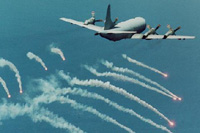|
Military Aircraft Design and Operation
"U.S. military aircraft are designed, developed, and operated to fill a need initially expressed in a DoD Mission Need Statement (MNS). They are special purpose aircraft that must operate efficiently in peacetime and effectively in wartime. As a result of this dual ‘peacetime–wartime’ environment, they have more requirements imposed upon them during the acquisition process than those imposed upon civilian aircraft. Table P.1 contains a list of some of the characteristics, capabilities, or attributes that must be considered when developing or acquiring a military aircraft. Some of them, such as ‘carries a large payload over a long distance,’ are operationally related; others, such as ‘easy to modernize,’ are not. Many of them, such as ‘stealthy’ and ‘delivers lethal weapons accurately,’ are unique to military aircraft. Of interest here is the relatively recent aircraft attribute known as survivability." (Ref. 1)
What is survivability, and how does it relate to system safety? Aircraft combat survivability (ACS) is defined in Ref. 1 as the capability of an aircraft to avoid or withstand a man-made hostile environment. It can be measured by the probability the aircraft survives an encounter (combat) with the environment, PS. The more general term aircraft survivability refers to the capability of an aircraft to avoid or withstand hostile environments, including both man-made and naturally occuring environments, such as lightning strikes, mid-air collisions, and crashes. The more traditional discipline known as system safety attempts to minimize those conditions known as hazards that can lead to a mishap in environments that are not made hostile by man. Thus, together, the system safety and survivability disciplines attempt to maintain safe operation and maximize the survival of aircraft in all environments in both peacetime and wartime. What is aircraft susceptibility? Susceptibility is the inability of an aircraft to avoid (the guns, approaching missiles, exploding warheads, air interceptors, radars, and all of the other elements of an enemy's air defense that make up) the man-made hostile mission environment. The more likely an aircraft on a mission is hit by one or more damage-causing mechanisms generated by the warhead on a threat weapon (e.g. warhead fragments, blast, and incendiary particles), the more susceptible is the aircraft. Susceptibility can be measured by the probability the aircraft is hit by one or more damage mechanisms, PH. Thus,
What is aircraft vulnerability? Vulnerability is the inability of an aircraft to withstand (the hits by the damage-causing mechanisms created by) the man-made hostile environment. The more likely an aircraft is killed by the hits by the damage mechanisms from the warhead on a threat weapon, the more vulnerable is the aircraft. Vulnerability can be measured by the conditional probability the aircraft is killed given that it is hit, PK|H. Thus, What is aircraft killability? Killability is the inability of the aircraft to both avoid and withstand the man-made hostile environment. Thus, killability is the ease with which the aircraft is killed by the enemy air defense. Killability can be measured by the probability the aircraft is killed, PK. Killability is given by the joint probability the aircraft is hit (its susceptibility) and it is killed given the hit (its vulnerability). Thus, PK = PHPK|HIf the threat weapon contains a high explosive (HE) warhead with proximity fuzing, the subscript H for a hit is replaced with an F for warhead fuzing. For a closer look at the words susceptibility and vulnerability, click here. How is an aircraft's combat survivability enhanced? The survivability of an aircraft is related to the aircraft's killability, or susceptibility and vulnerability, by the equation PS = 1 - PK = 1 - PHPK|HThus, an aircraft's combat survivability is enhanced when it's killability is reduced. The killability of an aircraft is reduced when the susceptibility and the vulnerability of the aircraft are reduced. Table P.2 presents a partial list of the many design and operational features that can enhance the survivability of an aircraft by reducing either the aircraft's susceptibility or its vulnerability.
According to Table P.2, an aircraft's susceptibility can be reduced by reducing the aircraft signatures (stealth), installing a threat warning system, employing on-board electronic attack equipment known as electronic countermeasures (ECM), mounting expendables (chaff and flares), and using survivable tactics, such as flying outside of the enemy weapon envelopes and preemptively destroying the enemy's air defense weapons. An aircraft is killed when one or more of its critical components is killed. According to Table P.2, an aircraft's vulnerability can be reduced by using redundant and separated critical components, such as multiple, widely spaced engines and hydraulic power components; designing critical components to contain or minimize any hit-caused damage, such as installing an On-Board Inert Gas Generator (OBIGGS) in fuel tanks to suppress internal fires and explosions and designing helicopter rotor blades to withstand a hit by a high explosive warhead; and using armor to shield critical components from the damage mechanisms.
What are the goals of the ACS discipline? According to Ref. 1, the goals of the ACS discipline are:
The survivability discipline is dedicated to saving lives in combat by reducing an aircraft's susceptibility and vulnerability at an affordable cost. If you want to learn more about survivability, you should click on the link to the AIAA survivability textbook at the top of the page. |
|||||||||||||||||||||||||||||||||||||||||||||||||||||||||||||||||||
|
Disclaimer: |
| Ref. 1. Ball, Robert E., The Fundamentals of Aircraft Combat Survivability Analysis and Design, Second Edition, AIAA, Reston, VA, 2003 (The AIAA Textbook) |

